Cognitive behavioral strategies for youth in sports enhance mental resilience and performance. This article covers the overview of these strategies, their applications such as goal setting and visualization, and the positive outcomes including increased confidence and reduced anxiety. Additionally, it highlights best practices for implementing these techniques effectively in a sports context.

What are Cognitive Behavioral Strategies for Youth in Sports?
Cognitive behavioral strategies for youth in sports enhance mental resilience and performance. These techniques focus on modifying negative thoughts, improving self-talk, and fostering a positive mindset.
Key applications include goal setting, visualization, and self-monitoring. For instance, athletes can set specific, measurable goals to track progress. Visualization helps them mentally rehearse performances, while self-monitoring encourages reflection on thoughts and behaviors during training and competition.
Outcomes of these strategies often include increased confidence, reduced anxiety, and improved focus. Research shows that athletes who utilize cognitive behavioral techniques are more likely to experience enhanced emotional regulation and overall satisfaction in their sports involvement.
How do these strategies enhance athletic performance?
Cognitive behavioral strategies enhance athletic performance by improving mental resilience and focus. These techniques help athletes manage anxiety, set achievable goals, and maintain motivation, leading to better training outcomes and competitive results. For instance, visualization techniques can enhance concentration, allowing athletes to perform under pressure. Additionally, positive self-talk can boost confidence, which is crucial during competitions.
What psychological principles underpin these strategies?
Cognitive behavioral strategies for youth in sports rely on principles such as cognitive restructuring and reinforcement. These strategies help athletes identify and modify negative thoughts, enhancing performance and emotional resilience. For instance, cognitive restructuring aids in developing a positive mindset, while reinforcement encourages consistent improvement through rewards. Understanding these principles fosters better mental health and athletic success.
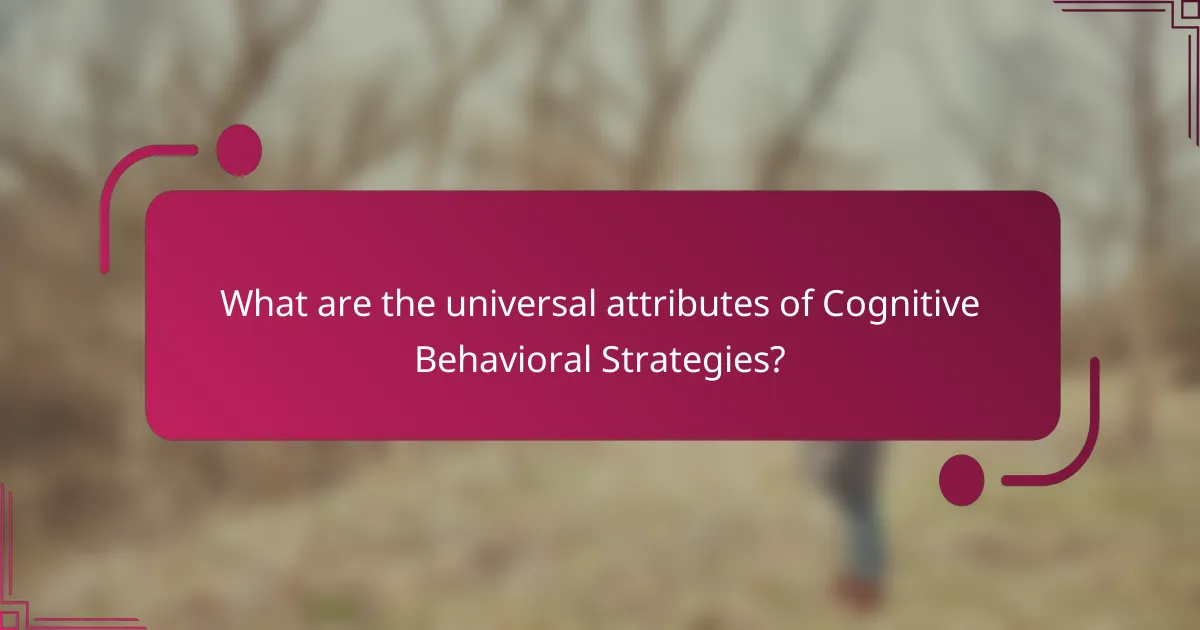
What are the universal attributes of Cognitive Behavioral Strategies?
Cognitive Behavioral Strategies for youth in sports share universal attributes that enhance mental resilience and performance. These attributes include goal-setting, self-monitoring, cognitive restructuring, and emotional regulation. Goal-setting provides clear targets, while self-monitoring fosters awareness of thoughts and behaviors. Cognitive restructuring helps athletes challenge negative beliefs, and emotional regulation aids in managing stress and anxiety during competition.
How do these strategies promote positive thinking?
Cognitive behavioral strategies promote positive thinking by challenging negative thoughts and fostering a growth mindset. These strategies help youth in sports develop resilience, enhance self-esteem, and improve performance. By focusing on specific goals and positive self-talk, athletes can shift their mindset from fear of failure to embracing challenges, leading to better outcomes. The structured approach of these strategies provides a framework for consistent practice, reinforcing positive beliefs and behaviors over time.
What role does goal setting play in these strategies?
Goal setting is crucial in cognitive behavioral strategies for youth in sports as it enhances focus and motivation. Setting specific, measurable, attainable, relevant, and time-bound (SMART) goals helps athletes track progress and build self-efficacy. Research indicates that clear goals lead to improved performance and greater resilience in facing challenges. Furthermore, goal setting fosters a growth mindset, encouraging young athletes to embrace learning and development.
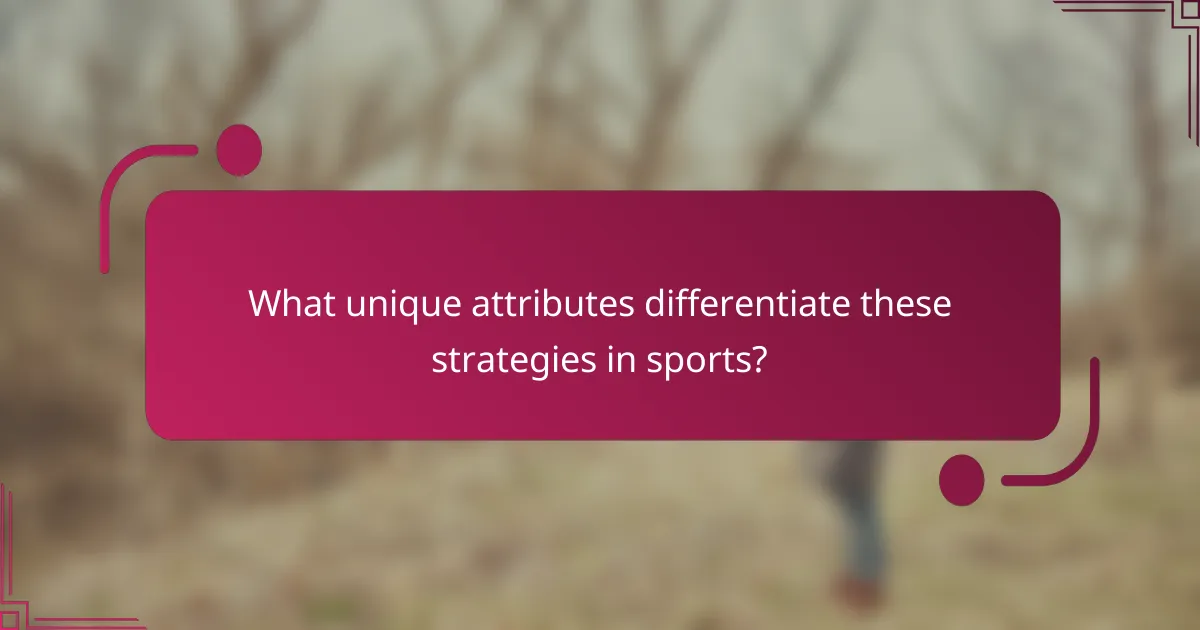
What unique attributes differentiate these strategies in sports?
Unique attributes of cognitive behavioral strategies in sports include their adaptability to individual needs, focus on skill development, and emphasis on mental resilience. These strategies uniquely integrate psychological techniques with physical training, enhancing performance and fostering a growth mindset. Additionally, they often involve personalized feedback mechanisms, which are rare in traditional coaching methods, allowing for tailored interventions that address specific challenges faced by youth athletes.
How do these strategies address mental resilience in young athletes?
Cognitive behavioral strategies enhance mental resilience in young athletes by fostering adaptive thinking patterns. These strategies teach athletes to identify negative thoughts, challenge them, and replace them with positive affirmations. As a result, athletes experience reduced anxiety and improved focus during competition. Techniques such as visualization and goal-setting further develop mental toughness, allowing young athletes to cope with pressures effectively. Studies show that consistent application of these strategies leads to better performance outcomes and greater enjoyment of the sport.
What specific techniques are employed to manage competition anxiety?
Cognitive behavioral strategies effectively manage competition anxiety through techniques like cognitive restructuring, exposure therapy, and relaxation training. These methods help athletes identify negative thoughts, gradually face anxiety-inducing situations, and develop coping mechanisms. Cognitive restructuring alters unhelpful beliefs, while relaxation techniques reduce physiological symptoms of anxiety.
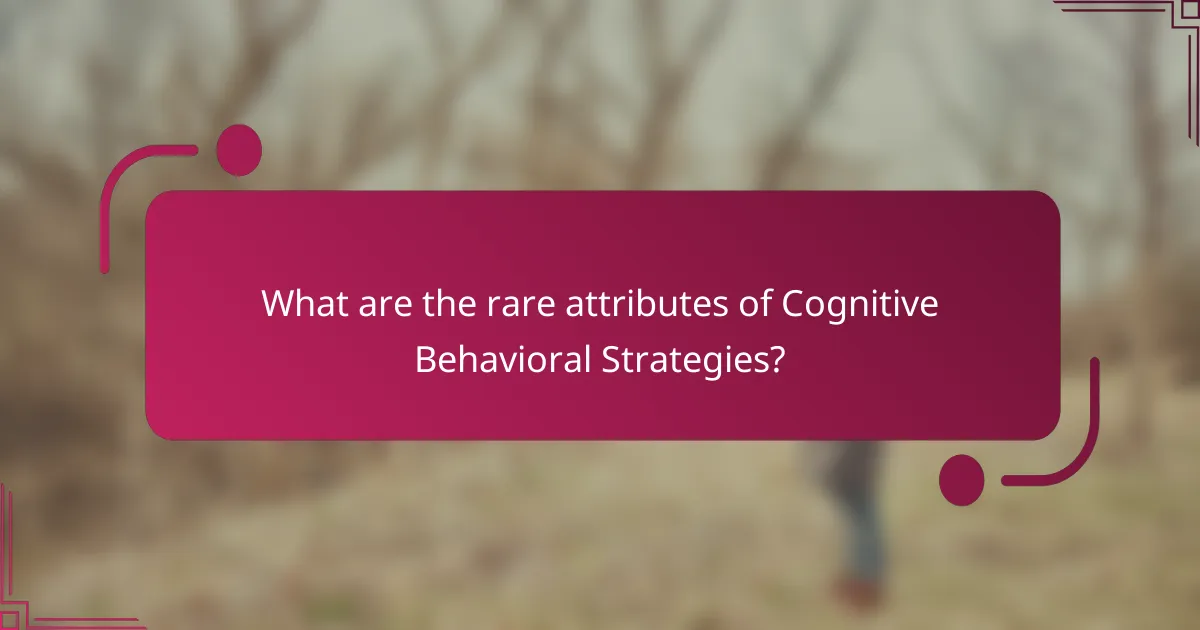
What are the rare attributes of Cognitive Behavioral Strategies?
Cognitive Behavioral Strategies for youth in sports exhibit rare attributes such as adaptability to individual psychological profiles, integration of virtual reality for skill enhancement, and focus on performance anxiety reduction through biofeedback techniques. These unique traits differentiate them from traditional coaching methods, allowing for personalized mental training approaches that cater to diverse athlete needs.
How do cultural factors influence the application of these strategies?
Cultural factors significantly shape the application of cognitive behavioral strategies in youth sports. These influences include values, beliefs, and social norms that dictate how athletes perceive competition and mental health. For instance, cultures emphasizing collectivism may prioritize team cohesion, affecting individual psychological approaches. Additionally, cultural attitudes toward failure can influence how youth respond to setbacks, impacting their resilience and motivation. Understanding these dynamics ensures that strategies are culturally relevant and effective, enhancing their overall outcomes in diverse settings.
What adaptations are made for different sports?
Cognitive behavioral strategies are adapted for different sports to address specific mental demands. These adaptations enhance focus, resilience, and performance optimization tailored to each sport’s unique challenges.
For example, team sports often emphasize communication and collaboration techniques, while individual sports may focus on self-motivation and visualization practices. Additionally, high-pressure sports like gymnastics or diving incorporate strategies for managing anxiety and enhancing concentration during critical moments.
The overall goal is to equip young athletes with mental tools that align with their sport’s requirements, fostering both personal growth and athletic success.

What are the practical applications of these strategies in youth sports?
Cognitive behavioral strategies have practical applications in youth sports by enhancing mental resilience, focus, and teamwork. These strategies help athletes manage anxiety, set achievable goals, and improve performance through structured mental training. For example, visualization techniques can boost confidence and prepare athletes for competition. Additionally, cognitive restructuring allows young athletes to reframe negative thoughts into positive affirmations, fostering a growth mindset. Overall, these applications lead to improved athletic outcomes and personal development.
How can coaches integrate these strategies into training?
Coaches can integrate cognitive behavioral strategies into training by incorporating mental skills exercises. These exercises enhance focus, resilience, and emotional regulation. For example, using visualization techniques can help athletes prepare for competitions. Regularly discussing goal-setting fosters a growth mindset. Additionally, encouraging self-reflection after practices or games allows athletes to identify strengths and areas for improvement. Implementing these strategies consistently nurtures mental toughness and overall performance.
What role do parents play in supporting these strategies?
Parents play a crucial role in supporting cognitive behavioral strategies for youth in sports. They provide emotional support, reinforce positive behaviors, and facilitate open communication. Active involvement helps youth develop resilience and coping skills, enhancing their performance and enjoyment in sports. Additionally, parents can model effective problem-solving techniques and encourage goal-setting, which are key components of cognitive behavioral strategies. Their engagement can significantly influence the outcomes of these strategies, fostering a supportive environment for young athletes.
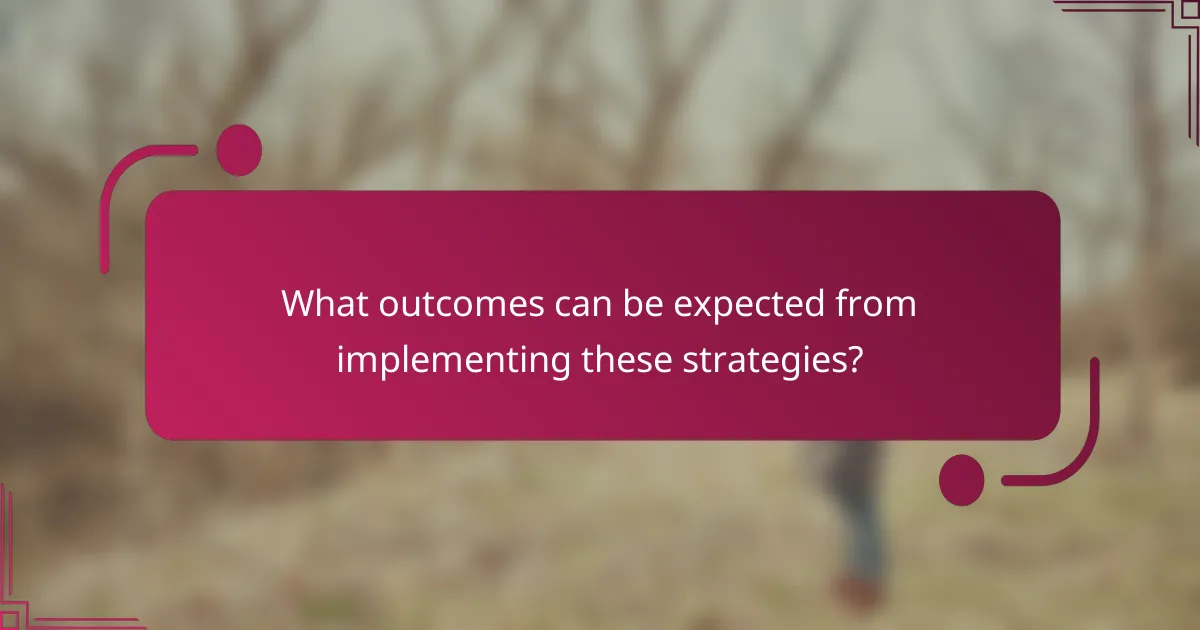
What outcomes can be expected from implementing these strategies?
Implementing cognitive behavioral strategies in youth sports leads to improved mental resilience, enhanced performance, and better emotional regulation. Participants often report increased self-confidence and reduced anxiety levels. These outcomes contribute to a more positive sports experience and foster long-term engagement in physical activities. Enhanced focus and goal-setting skills are also common benefits, supporting both athletic and personal development.
How do these strategies affect teamwork and communication?
Cognitive behavioral strategies enhance teamwork and communication by fostering a positive mindset and effective interaction. These strategies promote self-awareness, enabling athletes to express thoughts and feelings constructively. Improved emotional regulation leads to better conflict resolution and collaboration. As a result, teams experience higher cohesion and performance.
What are the long-term benefits for young athletes?
Young athletes experience numerous long-term benefits from cognitive behavioral strategies. These strategies enhance mental resilience, improve focus, and foster a positive mindset, contributing to better performance and overall well-being. Research indicates that athletes who engage in cognitive behavioral techniques demonstrate reduced anxiety and increased self-confidence, leading to sustained athletic success. Additionally, these strategies can improve decision-making skills and emotional regulation, essential for both sports and life beyond athletics.
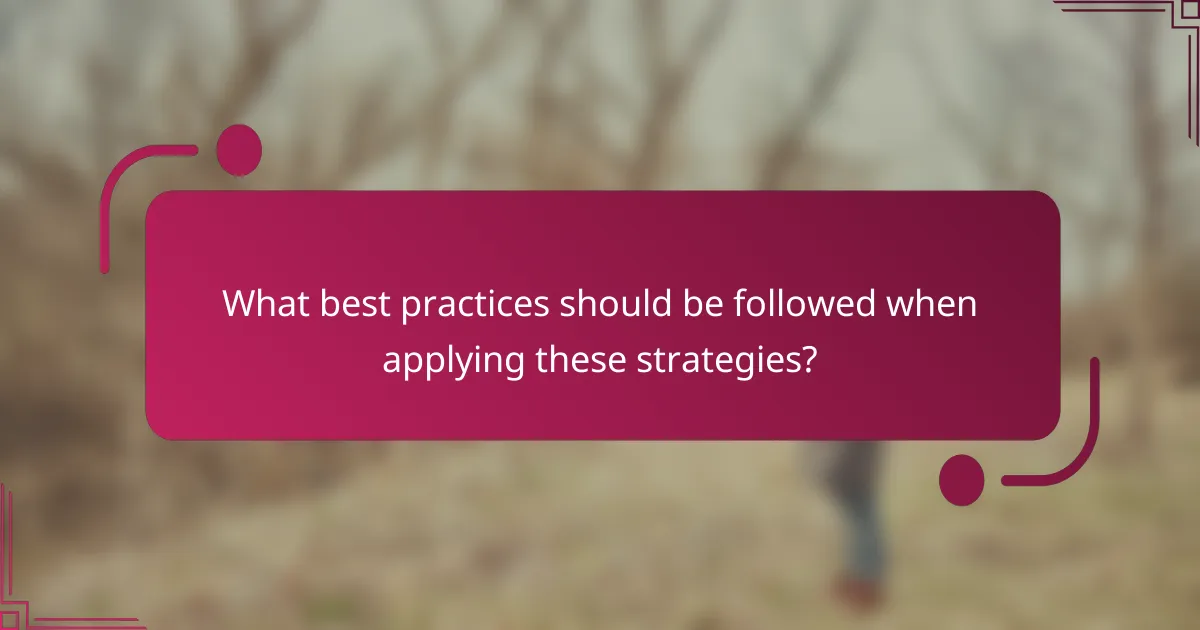
What best practices should be followed when applying these strategies?
To effectively apply cognitive behavioral strategies for youth in sports, focus on these best practices: establish clear goals, maintain open communication, promote a positive mindset, and incorporate regular feedback. These strategies enhance performance and well-being.
1. Set specific, measurable goals to guide progress.
2. Foster an environment of trust to encourage dialogue.
3. Use positive reinforcement to build confidence.
4. Implement consistent evaluations to track development.
What common mistakes should practitioners avoid?
Practitioners should avoid common mistakes such as neglecting individualized approaches, failing to establish clear goals, and overlooking the importance of mental resilience. Additionally, not fostering open communication can hinder progress. These pitfalls can diminish the effectiveness of cognitive behavioral strategies in youth sports.
How can ongoing evaluation improve strategy effectiveness?
Ongoing evaluation enhances strategy effectiveness by providing real-time feedback and adjustments. This process allows coaches to refine cognitive behavioral strategies based on youth athletes’ performance and mental resilience. Regular assessments identify strengths and weaknesses, fostering continuous improvement. Additionally, adapting strategies to individual needs ensures more effective outcomes, promoting a supportive environment for athletes.